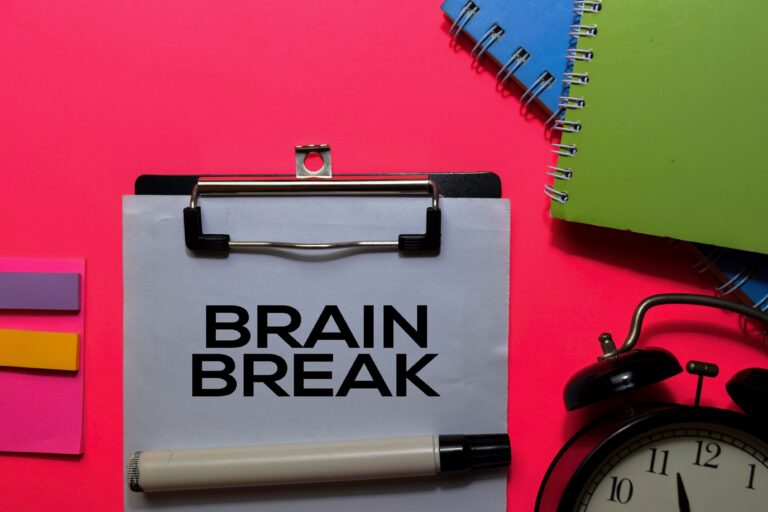The Science Behind Brain Breaks
Most educators experience students’ glazed eyes, heads down, whispering, texting under the table and disruptive classroom behavior. While frustrating to teachers, these behaviors indicate that students are overdue for a brain break. Dr. Judy Willis, author of “Research-based Strategies to Ignite Student Learning: Insights from Neuroscience and the Classroom” informs educators that the requests for water, bathroom, and behavior flare-ups may not be excuses to skip out on work. Granted, let’s be honest, sometimes they are! However, teachers who understand brain science know why these student behaviors happen. It’s natural for students to get fidgety, off-task, and drive us to our last nth of sanity by the end of the week!
Don’t flee the education field demoralized like a wounded soldier. Arm yourself every morning with brain science-backed strategies for effective teaching and energized students. Brain science explains how to fight off student disengagement before it occurs (Willis, 2020).
Learning begins at the Reticular Activating System (RAS) inside the brain. Our students’ RAS filters an enormous amount of sensory information created by the environment. Imagine the RAS as the sifter you use when sifting flour to bake a cake. Visualize one tiny grain of flour falling into the bowl from a five-pound bag. That is the power of the RAS. Luckily, students can manipulate the RAS intake as they get older (Willis, 2020).
The RAS alerts the brain to stimuli for protection from danger. Hence, any external stimuli more exciting than the teacher wins! While great for directing focus to emergencies, the RAS does not always serve our student population. If a student finds the curriculum or the teacher’s delivery mundane, the RAS blocks the information from entering the prefrontal cortex or “higher brain.” The results: Students are not learning. Likely, students did not even process the teacher’s words. Can you hear the echoes of, “What page is it on again?” Students can listen and retain a page number. Unfortunately, their RAS was busy letting in other sensory information instead of the teacher’s instruction (Willis, 2020).
Competing to make it through the RAS filter is the first step in better teaching practices and improving student achievement. Our voices must be the sensory information launched into the prefrontal cortex where memory and critical thinking occur. Then, students connect previously learned information to the current lesson for the chance of the information going from short to long term memory (Willis, 2020). As educators, we must stare ourselves down to find the facets of content delivery which lose the RAS fight.
We reminisce over decades of “sit and get” teaching, but that methodology does not meet the 21st century students’ needs. Willis’s 2020 brain science and education research tells us that students learn through appealing entertainment. Essentially, today’s effective teacher is a “teachertainer.”
The Benefits of Brain Breaks for Classroom Management and Academic Achievement
Teachertainers teach higher-order thinking strategically in brain breaks and lock freshly learned skills into the prefrontal cortex on the sly! Think with me for a second. A brain break, in its essence, is a time used to relieve cognitive stress, boredom, and frustration. Teachertainers purposefully use brain breaks to reset attention, focus, motivation, and the joy of learning with activities students perceive as a “break.” Don’t waste time letting your students sit and gossip! Willis (2020) details a myriad of strategies to tap into strengthening neural connections in the brain and boosting intrinsic motivation in, “Research-based Strategies to Ignite Student Learning: Insights from Neuroscience and the Classroom.”
Teachertainers frame the brain break as a “break” from complex thinking, but secretly, it’s where learning, memory storage, and classroom management overhauls can occur!
Here’s the kicker: Short brain breaks need to happen before boredom sets in. This allows the information to move to working memory (Willis, 2020). Especially for middle and high school students, hearing the word “break” increases dopamine levels refreshing the brain’s curiosity and receptiveness to learning.
Teachertainer Strategies
Choosing activities that build a collaborative team spirit is a classroom climate booster. A simple student-led Simon Says game increases oxygen flow to the brain as students unwittingly practice focus and attention skills. Teachertain with encouragement and laughter, transforming any student awkwardness into positive energy.
Try handing students mini-whiteboards and markers. Ask them to draw a symbol representing happiness but restrict drawing the typical emoji or smiley face. Watch small grins circle the room as students’ imaginations spin the details of their personalized happy symbol. Have students close their eyes. No peeking! Quickly swap the whiteboards. Ask students to play a guessing game matching each student to the right symbol. Teachertain by celebrating students’ individualities. Act as if you hit the MegaMillions Jackpot with awe and enthusiasm for students’ creative connections. Don’t forget to lead snapping or clapping for each correct guess!
After a few days of brain “break” strategies like these, classroom management begins to take care of itself. Watch student leaders defend a classmate against an unkind jest. Students advocate for what they value. Now, they value each other’s contribution to the team.
With harmonious classroom management, the Teachertainer can seamlessly weave in and out of brain breaks, continually elevating students’ love for learning and each other.




